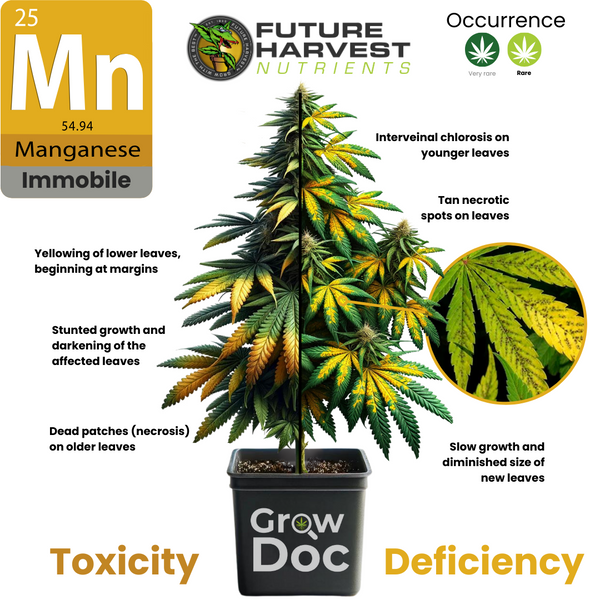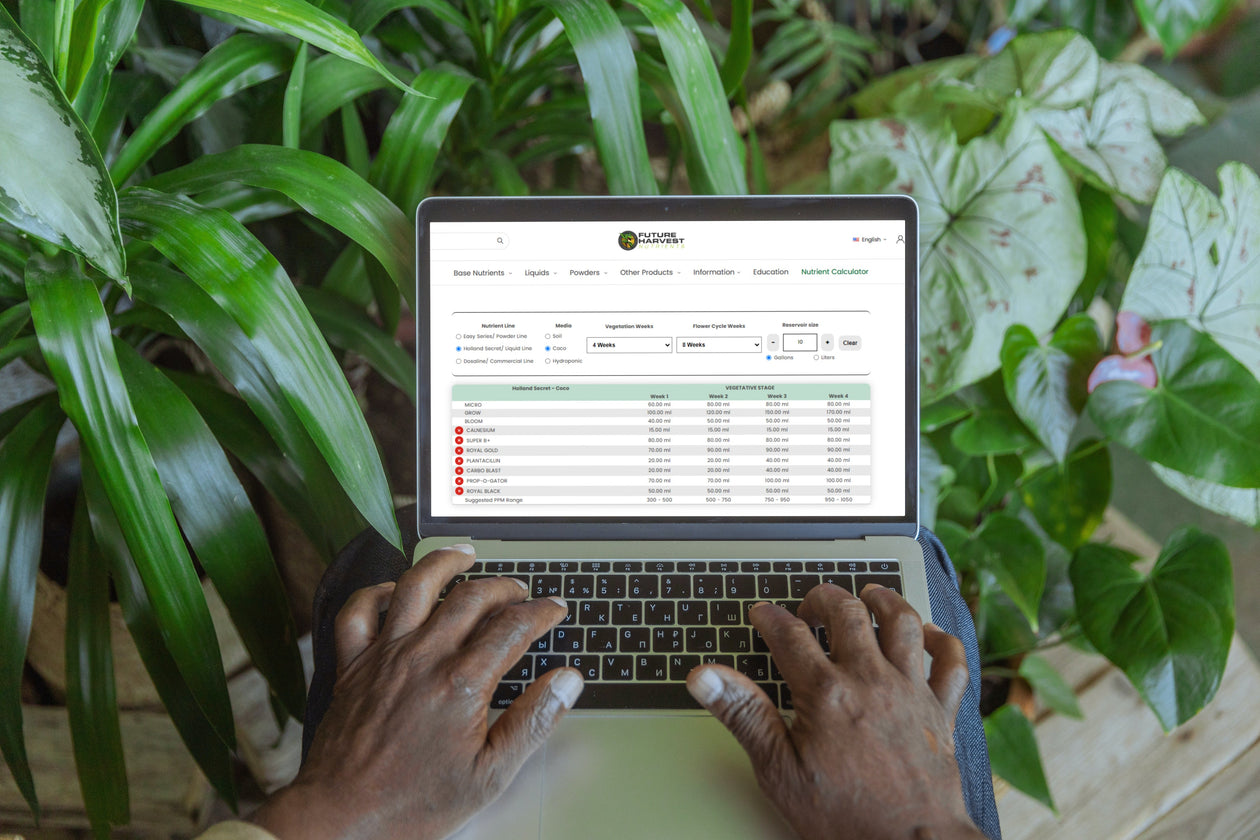How to Find and Fix Manganese Deficiency in Cannabis Plants

Manganese Deficiency and Toxicity in Cannabis Cultivation
Manganese, a lesser-known but vital nutrient in cannabis cultivation, plays a critical role in the life of plants. It’s integral to photosynthesis, chlorophyll production, and environmental stress resistance. A cannabis plant's deficiency or excess in manganese can dramatically affect its growth and health.
This article, part of our ongoing series on nutrient management, delves into manganese's essential role and how to maintain the delicate balance needed for optimal plant health. Whether you're a novice or experienced grower, understanding manganese's impact is crucial for cultivating thriving cannabis plants.
Did You Know?
Manganese is a multi-faceted micronutrient critical for your cannabis plants. It oversees the plant's energy management by regulating carbohydrate metabolism and is key to nitrate reduction. Plus, it's the Mn+2 form of manganese that your plants are hungry for, out of the three valencies it presents in the soil.
Discover More Manganese FactsThe Role of Manganese in Cannabis Plants
Manganese is crucial for cannabis, especially in photosynthesis, where it helps plants turn light into energy. It’s vital for nitrogen metabolism, impacting chlorophyll and protein synthesis. Manganese also supports strong root growth and helps plants absorb nutrients and water efficiently.
It boosts the plant's defense against diseases and is necessary for pollen production, important for seed development in non-feminized strains. Even though it's needed in small amounts, manganese's role in plant health and yield is significant. Ensuring plants have enough manganese is key to their growth and resilience.
Manganese and Plant Health
If the pH drifts too far from the ideal range, manganese can become scarce, leading to deficiencies, or excessively available, causing toxicity. Maintaining the right pH ensures manganese aids in essential functions like photosynthesis and defense against diseases, supporting strong growth and resilience in cannabis plants.
Expert Insight
Recent studies have indicated that adequate manganese levels can enhance the efficacy of other nutrients, like iron and zinc, creating a synergy that bolsters the plant's photosynthetic efficiency and stress tolerance. This synergy is important in optimizing nutrient uptake and utilization, particularly in changing environmental conditions.
Common Causes for Manganese Imbalances in Cannabis Cultivation
Manganese imbalances in cannabis cultivation can stem from a variety of environmental and nutritional factors that either impede its absorption or lead to an excess. Here are the intertwined causes and considerations for managing manganese levels effectively:
-
pH Levels: Both deficiency and toxicity can be traced back to pH imbalances. Manganese is optimally available in slightly acidic to neutral pH ranges. Outside this zone, either too low or too high, manganese becomes either too available or not available enough. Adjusting and maintaining the pH within the ideal range (5.5 to 6.5 for hydroponics and 6.0 to 7.0 for soil) is crucial for balanced manganese uptake.
-
Nutrient Interactions: The presence of other nutrients affects manganese absorption. High levels of iron, calcium, or phosphorus can outcompete manganese, reducing its uptake. Conversely, excessive manganese can inhibit the uptake of these and other nutrients, highlighting the need for balanced fertilization practices.
-
Watering Practices and Soil Conditions: Overwatering can lead to manganese leaching in sandy or well-draining soils, while under-watering or poor drainage can cause accumulation and potential toxicity, especially in compacted soils or those with low organic matter. Ensuring proper watering practices and soil aeration can mitigate these risks.
-
Temperature and Root Health: Cold soil temperatures slow down microbial activity and nutrient uptake, including manganese. Additionally, root health is paramount; damaged or diseased roots struggle to absorb manganese effectively, regardless of its availability in the growing medium.
-
Organic Matter and Amendments: While organic matter improves soil structure and nutrient content, excessive amounts can bind with manganese, making it less accessible. Similarly, the use of manganese-rich fertilizers or amendments without proper consideration of existing soil manganese levels can lead to toxicity.
How to Find: Identifying Manganese Deficiency and Toxicity
Identifying manganese imbalances early is crucial for mitigating damage and ensuring the health of your cannabis plants. Here’s a guide to recognizing the telltale signs:
Manganese Deficiency Symptoms in Cannabis Plants
- Interveinal Chlorosis: Initial symptoms include yellowing between the veins of young leaves while the veins remain green. This distinct pattern is a classic sign of manganese deficiency.
- Necrotic Spots and Blemishes: As the deficiency progresses, small, dark or dead spots appear on the affected leaves, indicating tissue death.
- Leaf Curling and Distortion: Leaves may become distorted, curl upwards, or develop irregular edges as the deficiency worsens.
- Overall Plant Stunting: A lack of manganese can significantly hinder growth, leading to stunted plants with weak stems and underdeveloped root systems.
Manganese Toxicity Symptoms in Cannabis Plants
- Darkened, Older Leaves: Excessive manganese typically affects the older leaves first, causing them to darken and take on a bluish-green hue.
- Chlorosis and Leaf Droop: Advanced toxicity may lead to chlorosis (yellowing) in new growth and a general droopiness in plant posture due to impaired nutrient and water uptake.
- Reduced Growth and Yield: Like deficiency, toxicity stunts plant growth but can also drastically reduce flowering and overall yield, as the plant's energy is diverted to coping with the excess manganese.
- Root System Damage: Toxic levels of manganese can harm the root system, making it brown and rotted, further reducing the plant's ability to absorb water and other nutrients effectively.

How to Fix: Manganese Deficiencies and Toxicities in Cannabis Plants
For Manganese Deficiency:
- Immediate Action: Apply a manganese-rich foliar spray directly to the leaves. This allows the plant to bypass root uptake issues, providing quick relief to deficiency symptoms.
- Soil Amendment: Introduce a manganese supplement into your feeding regimen. Opt for chelated manganese for easier absorption. Ensure you follow the recommended dosage to avoid overcorrection.
- pH Adjustment: Sometimes, manganese deficiency is caused by incorrect pH levels hindering nutrient uptake. Adjust your growing medium's pH to the optimal range for cannabis (6.0 to 6.5 for soil and 5.5 to 6.5 for hydroponics) to enhance manganese availability.
For Manganese Toxicity:
- Cease Manganese Supplementation: Immediately stop all manganese supplements. The goal is to halt further accumulation of manganese in the plant.
- Flush the Growing Medium: Use pH-balanced water to flush out excess manganese from the soil or hydroponic system. This helps reduce manganese levels around the root zone and prevents further uptake.
- Rebalance Nutrients: After flushing, reintroduce a well-balanced nutrient solution minus the manganese. Monitor your plants for signs of recovery, adjusting your nutrient strategy to prevent future toxicities.
- Monitor and Adjust pH: Ensuring the growing medium's pH is within the optimal range is crucial. A balanced pH helps regulate the availability of manganese and other nutrients, preventing imbalances.
Maintaining Optimal Manganese Levels
Achieving the right manganese balance is crucial for cannabis health. Regularly testing your soil or hydroponic system for pH and nutrient levels helps prevent manganese imbalances. Aim for a pH range conducive to manganese uptake—6.0 to 6.5 for soil and 5.5 to 6.5 for hydroponics. Incorporate a nutrient regimen that meets your plants' needs at every growth stage, emphasizing manganese during critical growth phases. Adjust based on plant growth and signs of nutrient imbalance to ensure your cannabis thrives.
Enhancing Manganese Uptake in Soil-Grown Cannabis
To optimize manganese absorption in soil:
- Amend Soil: Apply manganese-rich amendments or chelated manganese products designed for easy root absorption.
- Optimize Root Health: Promote a healthy root system through proper aeration and watering practices. This improves the plant's ability to take up manganese and other essential nutrients.
- Microbial Inoculants: Introduce beneficial microbes to enhance nutrient availability. These microbes can improve soil texture and nutrient exchange, making manganese more accessible to plants.

Optimize Your Feeding Schedule with Future Harvest
Conclusion and Next Steps
Understanding manganese's role and maintaining its optimal levels are key to cultivating healthy, productive cannabis plants. By addressing any signs of manganese deficiency or toxicity early and adjusting your cultivation practices accordingly, you can ensure your plants have the necessary nutrients throughout their lifecycle.
As you delve deeper into nutrient management, remember the importance of each element, including manganese, in supporting plant health and yield. Continuous learning, observation, and adjustment are the cornerstones of successful cannabis cultivation. Stay informed, monitor your plants closely, and adapt your strategies to meet their evolving needs for a fruitful harvest.
Explore Nutrient Deficiencies and Toxicities
| Nitrogen | Phosphorus | Potassium |
| Calcium | Magnesium | Sulfur |
| Boron | Iron | Manganese |
| Symptomology Guide | ||
